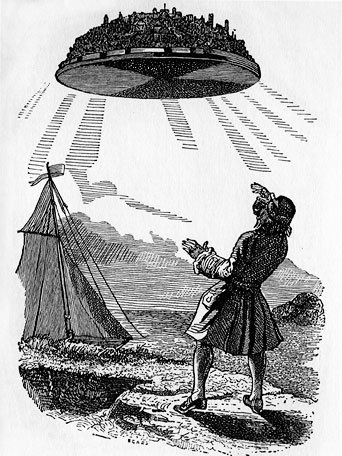Missing 'Island' Floating In Earth's Atmosphere

A floating "island" is at large somewhere in the Earth's atmosphere.
The 23-foot-wide, helium-filled model of a desert island was constructed by two artists for a festival in Cambridgeshire, England. Tethered by ropes, it hovered above a lake on the grounds of the Secret Garden Party festival until the wee hours of July 24, when vandals let it loose. Reminiscent of the airborne island of Laputa in "Gulliver's Travels," it floated away.
Based on meteorological data, the inflatable's creators say "Is Land," as they call their art piece, may be hovering in the troposphere above the Czech Republic by now. They've asked for help retrieving it via their website.
"What goes up must come down, so the hunt is on," Royal College of Arts graduates Sarah Cockings and Laurence Symonds wrote. "If what looks like a floating chunk of earth turns up in your Nan's back garden, or if you think you see a new planet intercept your Easyjet flight to the Algarve, please don't hesitate to get in touch."
"Is Land" was next slated to appear at the Burning Man festival in Nevada at the end of August. "Is Land is made of durable polyurethane with foliage décor and so, if found, can be repaired and go on to make its maiden voyage to the US of A," Cockings and Symonds wrote. If it doesn't turn up, sponsors of the Secret Garden Party festival said they'll foot the almost $15,000 bill to make another.
This article was provided by Life's Little Mysteries, a sister site to LiveScience. Follow us on Twitter @llmysteries, then join us on Facebook. Follow Natalie Wolchover on Twitter @nattyover.
Get the world’s most fascinating discoveries delivered straight to your inbox.
Natalie Wolchover was a staff writer for Live Science from 2010 to 2012 and is currently a senior physics writer and editor for Quanta Magazine. She holds a bachelor's degree in physics from Tufts University and has studied physics at the University of California, Berkeley. Along with the staff of Quanta, Wolchover won the 2022 Pulitzer Prize for explanatory writing for her work on the building of the James Webb Space Telescope. Her work has also appeared in the The Best American Science and Nature Writing and The Best Writing on Mathematics, Nature, The New Yorker and Popular Science. She was the 2016 winner of the Evert Clark/Seth Payne Award, an annual prize for young science journalists, as well as the winner of the 2017 Science Communication Award for the American Institute of Physics.



